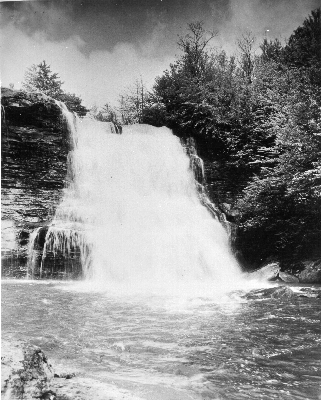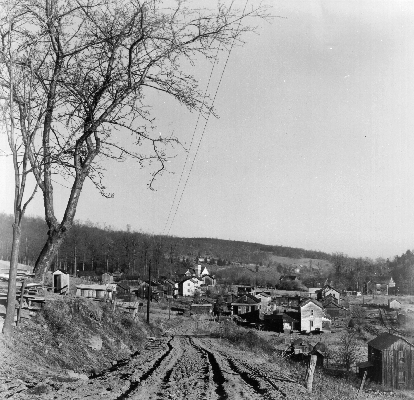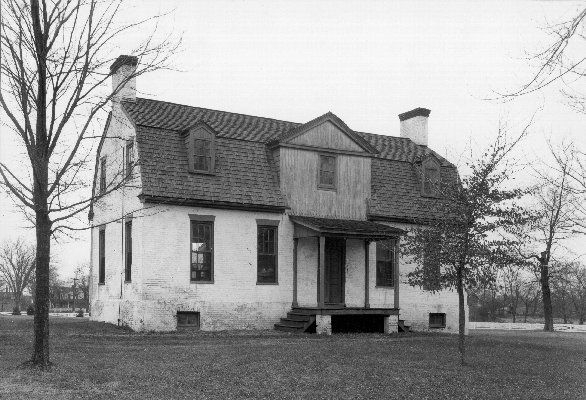 MSA
SC 908-39
MSA
SC 908-39
The italicized captions next to some of the images
are from "Maryland: A Guide to The Old Line State" compiled by workers
of the Writers' Program of the Work Projects Administration in the State
of Maryland and published in 1940.
Ice Wagon on Pinkney Street in Annapolis, circa 1935
 MSA
SC 908-147
MSA
SC 908-147
The Thomas Viaduct in Baltimore County, circa 1935
"In the face of widespread criticism, Benjamin F. Latrobe proposed and saw carried through construction of the Thomas Viaduct, carrying the Baltimore and Ohio Rairoad tracks across the Patapsco River on the line from Baltimore to Washington. About $150,000 was spent on "Latrobe's Folly," as the 612 foot span, constructed of 24,000 cubic yards of local granite, was called. When the first tiny locomotive, drawing a short string of lilliputian coaches, crept across the bridge July 4, 1835, President Philip E. Thomas of the B&O stood by confidently waiting the structure's collapse. Today, the viaduct, which bears Thomas' name, carries the heaviest and fastest of B&O's modern locomotives and coaches, and is regarded by engineers as one of the sturdiest structures of its kind in the country."
--Potential caption information attached to the photograph
Assembly of the wing of a Martin B-26 Airplane at the Glenn L. Martin Company in Baltimore County, 1940
"The State has become an aircraft producer of national and international importance since the Glenn L. Martin Company plant was built at Middle River. This concern is know throughout the world for its 'China,' 'Philippine,' and 'Hawaiian' Clippers, among the world's largest flying boats. It has produced both military and commercial planes for a number of foreign countries and has built many bombers and patrol planes for the U. S. Navy. In 1939 it expanded its plant considerably and now employs 12,000 workers."
-- page 75
 MSA
SC 908-208
MSA
SC 908-208
Sorting tomatoes for canning at Krig's Creek, Allegany
County, circa 1935
 MSA
SC 908-224
MSA
SC 908-224
Allegany County Public Library, circa 1935. This building was the Allegany Academy from 1798 to 1929.
 MSA
SC 908-240
MSA
SC 908-240
Mountain scene in Garrett County, circa 1935
Hill cabin in Garrett County, circa 1935
"Mountain Folk of extreme Western Maryland eke out a precarious living; some by working in mines or industrial plants, some by working small mountainside farm plots."
-- Potential caption information attached to the photograph
 MSA
SC 908-252
MSA
SC 908-252
Muddy Creek Falls, Garrett County, circa 1935
 MSA
SC 908-253
MSA
SC 908-253
Jennings, Maryland. A lumber town in Garrett County, December 1937
Photographer: Rothstein
The meat house belonging to the Manning House in East New Market, Dorcester County, circa 1935
"MANNING HOUSE, on Main Street, south of State 14, is a three-story painted brick dwelling formerly the East New Market Hotel. It is sometimes called the Old House of the Hinges because of the great hinges on the meat house to the rear. The cornice has tapering modillions with guttae below. Said to have been built by one of the Ennalls, it came subsequently into the posession of Anthony L. Manning, and officer in the War of 1812."
-- page 403
 MSA
SC 908-494
MSA
SC 908-494
Middleham Chapel, Calvert County, circa 1935
"MIDDLEHAM CHAPEL stands in a grove of shellbark hickory trees. In the high gable end of the simple brick building is the date 1748. Its predecessor, a chapel of ease of Christ Church, stood about nine miles to the north. In 1746 the vestry petitioned the assembly to levy the sum of 80,000 pounds of tobacco to build a new chapel because the old one 'is by Length of Time become ruinous and by increase of the Inhabitants, too small for the congregation.' Their request was granted and the present cruciform building erected. Middleham has no regular services."
--page 458
 MSA
SC 908-535
MSA
SC 908-535
Charlotte Hall, St. Mary's County, circa 1935
"The school of CHARLOTTE HALL was opened under charter of 1774 and named for Queen Charlotte of England. It became a military academy about 1797. The main building is a light gray, two-story square structure with a tall portico."
--page 476
 MSA
SC 908-553
MSA
SC 908-553
Sunday in Leonardtown, St. Mary's County, May 2, 1937
Photographer: E. Merritt
"The twentieth century has made little impression on LEONARDTOWN (90' altitude, pop. 697), where oxen trundle tobacco along the tree-lined lanes to the warehouses and boat landings, and the warm hospitality of the people has not yet been commercialized. In 1708 the Assembly ordered Seymour Town laid out here on a ridge overlooking Breton Bay, an estuary of the Potomac. A log courthouse was built and in 1710 succeeded St. Marys as the county seat. When the Assembly renewed its order in 1728 and provided means for carrying it out, Seymour Town -- named for Governor Seymour of the province -- was renamed in honor of Benedict Leonard Calvert, fourth Lord Baltimore. In addition to its two-century-old trade in tobacco, Leonardtown ships oak and gumwood logs for piles and railroad ties."
-- page 478
 MSA
SC 908-667
MSA
SC 908-667
Sawmill south of Salisbury, Wicomico County circa 1935
"Most of Salisbury's industries depend on products from the surrounding countryside. Large mills manufacture construction woodwork as well as crates, baskets, and barrels for farm produce shipped from the region. . . . "
--page 293
Main Street, Salisbury, Wicomico County, circa 1935
"SALISBURY (23' altitude, pop.10,997), an industrial and shipping point at the head of the Wicomico River, is the largest town on the Eastern Shore and the second largest port in Maryland. Its rapid growth is a contradiction of the traditional quiet and gentle pace of the Eastern Shore. . . .
Comfortable Victorian dwellings line narrow shady streets in the older residential section. Madern homes on parklike lawns are rising in the newer, outlying real-estate developments. . . . Institutions include a large hospital serving a wide area, a State teachers' college, two homes for the ages administered by private endowment, a children's home, a new public library, and many churches. The powerful influence of the Methodist ministry is largely responsible for county laws forbidding the serving of hard liquor at restaurants and the holding of Sunday entertainments for paid admission. These prohibitions have little effect, however, on the social life of most of the wealthy citizens, busy with their horse shows, fox hunts, and contests and entertainments at the country clubs. . . "
--pages 292 and 293
 MSA
SC 908-708
MSA
SC 908-708
Marlin Fishermen, Ocean City, Worcester County, circa 1935
". . . Though many species of fish, including croakers, bluefish, and weakfish (trout), are cought by anglers in the surf and still-fishing from boats on ocean and bay, it is the big-game fishing that has brought Ocean City its greatest fame in recent years. Channel bass (drum) and tuna of great size are taken frequently, and white marlin, averaging 70 pounds, are found from 20-30 miles out at shoals called the Jack Spot, the Tide Rips, Fenwick's Ridge, and Winter Quarter.
For white marlin fishing, crusiers are equipped with tall, flexible outrigger poles fastened upright amidships; from the angler's rod the heavy line goes to the top of an outrigger for trolling outside the wake. The marlin strikes the bait with its long, sharp bill, knocking the line from the clothespin on the outrigger. for an instant the bait lies at the surface before the fish takes it. Then follows a terrific fight as the big fish leaps from the water time after time, played by the angler who uses both arms and nearly all muscles. If the marlin stays hooked it is finally brought to the boat after from twenty minutes to two hours of battle, and is pulled on deck by its bill. A marlin caught from Ocean City in 1937 weighed 130 pounds. Several hundred are caught annually and it is a rare day when none of the boats has any luck."
-- pages 381 and 382
Back to Photographs at the Maryland State Archives
© Copyright August 28, 1997 Maryland State Archives
|
Tell Us What You Think About the Maryland State Archives Website!
|